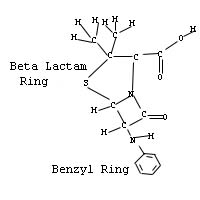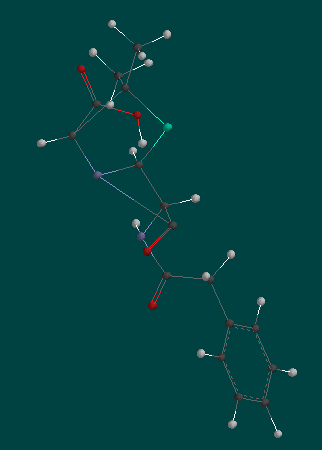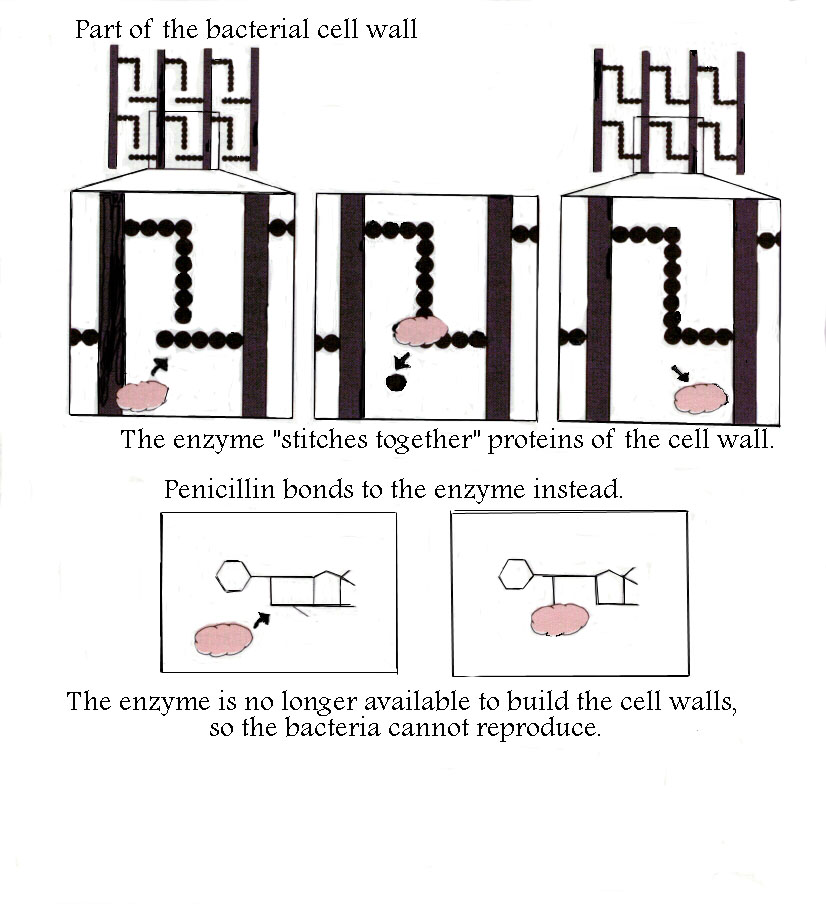Application
What's your problem?
Penicillin was first discovered by Sir Alexander Fleming in 1928. He observed a mold which secreted a substance that killed bacteria. This substance is penicillin. The first drug quality penicillin was not produced until 1940. The drug quickly became very popular because of its high activity rate and lack of toxicity. It became known as a wonder drug which cured many different types of diseases. Since then it has become the drug of choice for the most common bacterial infections.
There are several types of penicillin, however not all are commonly prescribed. In this model we are concered with penicillin G sodium, penicillin G potassium, and penicillin V potassium.* The letters designate different molecular forms of the drug.
The image to the right is a structural model of penicillin G. Each ball is an atom, and each wire is a bond between the atoms. Grey atoms are hydrogen, red atoms are oxygen, black atoms are carbon, green atoms are sodium, and purple atoms are nitrogen. The ring shape in the bottom right corner is a benzyl ring, a set of six carbon atoms bonded into a ring shape. Other groups of atoms can appear on this end of the penicillin molecule. Different types of penicillin (ie, penicillin G, V, etc) have different structures there. The twisted ring in the upper region is called the beta lactam ring; it is the active area of the penicillin molecule. Every type of penicillin has the same beta lactam ring. Below is a chemical structure for the penicillin G molecule, in roughly the same form as the image to the right.
 |
 (Molecule rendered on an SGI Indigo 2 with Spartan) (Molecule rendered on an SGI Indigo 2 with Spartan)
|
The sodium or potassium after the drug indicates which salt the penicillin is bound to. The different types of penicillin differ in the the absorption rates, excretion rates, protein binding, availability and fluid volume through which the drug is distributed. Penicillin G is the most active by weight of the different types but more likely to be administered by injection. Both forms can be damaged by the acidity of the stomach, but penicillin G is more sensitive. Because it is so sensitive, penicillin should be taken on an empty stomach.
Penicillin acts on bacteria by preventing cell wall formation. Once it is distributed throughout the body, it is taken up into bacterial cells. When these cells try to divide and form more cells, penicillin bonds irreversibly to a key enzyme for cell wall production. This bonding occurs on the area of the molecule between the sodium and nitrogen atoms on the structure shown above. That area is called the beta-lactam ring. Shown below is a graphical represntation of how the beta-lactam ring bonds to the necessary enzyme.

Because penicillin prevents cell wall formation, it is more effective at interfering with bacteria while they are actively dividing. Bacterial that are at rest are not affected as strongly by penicillin. Since viruses do not have cell walls, they are not susceptible to penicillin.
The following table shows various types of pathogens that can be treated by using either penicillin G or penicillin V.
| Pathogen | Condition Caused |
| Staphylococci | Sore throat, skin infections, etc |
| Streptococci | Sore throat, skin infections, etc |
| S. pneumoniae | Bacterial pneumonia |
| Bacillus anthracis | Anthrax |
| Neisseria gonorrhoeae | Gonorrhea |
| Treponema pallidium | Syphilis |
Penicillin, once it is taken orally, spreads throughout the body. It is absorbed from the gastrointestinal tract to the plasma (the bloodstream). Once it has reached the plasma, it is distributed throughout the body. Penicillin can be inactivated in three ways: protein binding, metabolism, or excretion. The liver metabolizes penicillin into an inactive compound which is excreted. Large proteins which are normally circulating in the plasma can bind to penicillin and inactivate it. Penicillin
is also filtered out of the body through the kidneys. The doctor who prescribes pencillin has to regulate the dose and the frequency so that a balance is found between the amount of drug coming into the body and the amount leaving the body. Our model shows how the concentration of drug in the plasma varies with depending on the size and frequency of the dose.
* This model is still a work in progress! At this time, the model assumes that penicillin G potassium is being used. We plan to update the form soon to allow the user to specify the penicillin type.
[Penicillin and You] [Application] [Algorithm] [Architecture] [Run the Model]
[Extensions] [Sources and Acknowledgements] [Glossary of terms] [Shodor home page]

